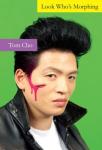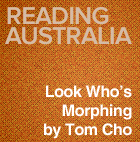AustLit
-
Look Who’s Morphing by Tom Cho is a collection of short stories in which a narrator, also called Tom, has surreal experiences in a range of situations. Deeply influenced by pop culture and highly intertextual and self-reflexive in nature, the collection references movies including Dirty Dancing, The Exorcist, and The Bodyguard. This intertextuality extends to the title of the book, which echoes the title of the 1989 Amy Heckerling film Look Who's Talking.
This trail below collects a range of items to enhance readers' engagement with the collection.
– Part One examines the book's pop culture references.
– Part Two discusses the self-reflexivity and autobiographical elements in the stories.
– Part Three draws together some of Cho's discussions of his work. The trail draws to a close by listing interviews, book reviews, and further reading. Some of these critical works and other resources are available to read online.
Click the hyperlinks in the citations below to be taken to the full text.
-
 Image courtesy of Giramondo PublishingSee full AustLit entry
Image courtesy of Giramondo PublishingSee full AustLit entryLook Who's Morphing is a collection of bizarre, funny, often menacing stories in which, along with his extended family, the central character undergoes a series of transformations, shape-shifting through figures drawn from film and television, music clips and video games, porn flicks and comics. He is Godzilla, a Muppet, and Whitney Houston's bodyguard; the Fonz, a robot, a Ford Bronco 4x4 - and, as a climax, a Gulliver-sized cock rock singer, played upon by an adoring troupe of sexy Lilliputians in short skirts and sailor suits and cheerleader outfits.
(...more) -
 By permission of Owen Leong.See full AustLit entry
By permission of Owen Leong.See full AustLit entryTom Cho graduated with a Bachelor of Arts degree (Professional Writing) from Deakin University in 1995, and completed a PhD in Professional Writing at Deakin in 2009. He has worked in the fields of writing and publishing, including jobs as a technical writer, freelance journalist, freelance editor, and proof-reader. While he continues to do freelance editing, Cho's primary work is in the arts industry, as an artist and artsworker (particularly within the field of community cultural development).
-
No One Puts Bruce in a Corner
The story 'Dirty Dancing' draws heavily from, but also deviates markedly from, the 1987 film Dirty Dancing. The clip below contains the famous line, 'Nobody puts Baby in a corner,' which is repurposed in Cho's story.
//www.youtube.com/embed/y97bWP33d8I -
The Sound of Music
In Cho's story 'The Sound of Music,' the narrator leaves the abbey to work for Captain Von Trapp, but the two begin 'having sex and falling in love' (45). Soon the narrator begins to merge into a version of Captain Von Trapp, and wonders, 'How do you solve a problem like co-dependency?' Of course, this story heavily references the film The Sound of Music, and even begins, like the movie, with an aerial shot of the narrator: 'At first, all you can see are clouds, then an aerial view of mountains, then a green valley, and a lake, and suddenly an open grassy area, and then there's me, spinning around with my arms outstretched, and I am singing' (43).
Tom Cho reads the story at the Paper Radio website. Online at http://www.paperradio.net/fm/the-sound-of-music. Sighted 09/12/2013.
//www.youtube.com/embed/KuWsQSntFf0 -
Godzilla
Godzilla, the reptilian 'King of the Monsters,' first appeared in film in 1954 and has since become a pop culture icon. Godzilla is mentioned often in Cho's stories. In 'Look Who's Morphing,' the narrator morphs into a 'giant reptilian creature' who is 'a combination of the best qualities of the world's lizards' (131). This Godzilla-like creature terrorises the eastern suburbs of Melbourne. Godzilla is also mentioned in 'Suitmation,' and in 'Cock Rock' the narrator is a 55-metre-tall version of himself who rampages through Tokyo as Godzilla did, only the narrator is not a reptile, but rather an oversized 1980s-style musician dressed in a leather vest and stonewash jeans, and carrying an electric guitar.
//www.youtube.com/embed/eSk-i1UFJWA -
The narrator of the stories in Look Who's Morphing seems to be consistent throughout the stories, and seems to share more than just a name with the author. One of the fun elements of this collection is the stories' insistent playfulness with autobiographical references. For example, perhaps the Auntie Wei character is modelled on the real-life author's aunt. Perhaps the real-life aunt even wore a novelty apron with plastic breasts, as the character does in the story 'The Exorcist.' But it seems unlikely that the real-life aunt would become possessed and speak in the narrator's voice, spitting back at him excerpts from his successful Australia Council grant applications. The resources below show critics and reviewers grappling with the seemingly autobiographical elements of the stories. Click on the hyperlinks in the citations below to be taken to the full text.
-
See full AustLit entry
In this review, Cyril Wong discusses the surrealism of Tom Cho's Look Who's Morphing, and what it might reveal about the author's subconscious. Wong suggests that 'Cho’s fantastical forays into the Twilight Zone of the diasporic-Chinese-queer-male mind tell us readers straightaway that his bizarre tales are, without a doubt, autobiographical, even confessional.'
(...more)Wong, Cyril. 'Cyril Wong Reviews Look Who's Morphing by Tom Cho.' Mascara Literary Review 5 (2009). Online at http://mascarareview.com/cyril-wong-reviews-look-whos-morphing-by-tom-cho/. Sighted 06/12/2013.
-
See full AustLit entry
Robinson suggests that 'Cho's work reflects back the problematic nature of identity, particularly in response to migration. But the book also speaks of other kinds of transitions - adolescence, sexual awakening, shifting familial relationships, employment - and the questions they raise about who we are. Cho demonstrates that when uncertainty arises, sometimes meaning is made and identity formed through nothing more substantial than story: "I said that, according to various myths and popular stories, morphing is accomplished via touch … that was no problem because myths and popular stories were also on television" (138).
(...more)Robinson, Alice. 'Becoming Tom Cho.' Rev. of Look Who's Morphing, by Tom Cho. TEXT 14.1 (2010). Online. Sighted 06/12/2013.
-
See full AustLit entry
Wong examines some of the claims made by Adam Rivett in his review of Cho's book Look Who's Morphing.
(...more)Wong, Cyril. 'The Acid Tongue: Look Who's Critiquing.' Quarterly Literary Review Singapore 8.3 (2009). Online at http://www.qlrs.com/acid.asp?id=696. Sighted 06/12/2013.
-
In this interview, Cho discusses his writing process, themes of morphing and transformation, and identity. He also talks about the mix of influences that inform his work, with particular reference to the short story 'Cock Rock.' He also responds to a question about his taste, and whether he differentiates between 'high' and 'pop' culture when including these influences in his work. At the end of the interview, he discusses criticism of the book.
Pearcy, Kate. 'Tom Cho's Morphing Short Stories.' Interview with Tom Cho by Kate Pearcy. The Book Show. ABC Radio National 14 April 2010. Online. Sighted 06/12/2013.
-
Tom Cho has written and spoken about the themes and preoccupations of his creative work, and his pop cultural and other influences. You can learn more about his approach to writing in the examples below. Click on the hyperlinks in the citations below to be taken to the full text or audio.
-
See full AustLit entry
Discussing his approach to writing the stories in Look Who's Morphing, Cho writes in this essay: 'I am not very interested in examining my engagement with popular culture in terms of popular cultural "references" or "allusions." In fact, rather than focusing on the insertion of popular cultural references in my collection, what especially strikes me about this collection is the literal insertion of my self into the text: in a range of stories from my collection, I appear in various "universes" derived from popular cultural texts/canons.
(...more)Cho, Tom. "'No One Puts Baby in a Corner": Inserting My Self into the Text.' Australian Humanities Review 45 (2008). Online. Sighted 06/12/2013.
-
'... [T]hrough some of the examples given in this paper, it is possible to see how the exploration of popular culture might provide writers with alternative approaches to exploring identity. Forms such as fan fiction can play with fluidity in fresh and fun ways. ' (The Author) (...more)See full AustLit entry
In this article, Cho discusses 'how contemporary fiction can explore popular culture and fluid identities in innovative ways,' and reflects on his own creative practice.
Cho, Tom. 'Look Who's Morphing: Popular Culture, Asian Identities and New Possibilities for Fiction.' Crossings: Bulletin of the International Australian Studies Association 9.3 (2004). Online. Sighted 06/12/2013.
-
See full AustLit entry
Cho discusses the cover of Look Who's Morphing (which features a photograph of the author), the textual 'intrusions' of his presence in the stories, the influence of trends on the stories' pop culture references, and whether short story writing was experiencing a surge of popularity at the time of the interview.
(...more)Pham, Hoa. 'Interview with Tom Cho.' Peril 7 (2009). Online at http://pandora.nla.gov.au/pan/62863/20091013-1608/www.peril.com.au/headline/interview-with-tom-cho.html. Sighted 06/12/2013.
-
See full AustLit entry
In this 'interview,' Cho responds to diverse prompts and discusses topics including the writing process, mixing signals, and gender.
(...more)Meyer, Angela. 'Tom Cho: A "Responsive" Interview.' Literary Minded blog. Crikey. 18 Jun. 2009. Online at http://blogs.crikey.com.au/literaryminded/2009/06/18/tom-cho-a-responsive-interview/. Sighted 06/12/2013.
-
Writing as Fun
Cho was a finalist in the 2009 Melbourne Prize for Literature for best writing. In this brief video Cho discusses Look Who's Morphing describing what motivates him to write.
//www.youtube.com/embed/q2lqrP1CGHA -
Cho has collected on his website tomcho.com a large number of reviews of Look Who's Morphing from a range of publications. Many of these reviews are available to read in archived versions of Cho's website, which have been preserved by the National Library of Australia's PANDORA archive.
-
Tom Cho's work is strongly connected to zine and fan fiction cultures.
Fan fiction is fan-written fiction that draws on existing fictional characters or worlds to tell or continue to tell stories.
Zines are self-published works that often include text and images, and are reproduced in small numbers. Zines are so diverse in nature, topic, and style that it is quite difficult to define them—which is part of their appeal. To learn more about zines, look at the websites of distributors such as The Sticky Institute or Take Care.
Academics who have written about zines include Anna Poletti, in her book Intimate Ephemera (Melbourne University Press 2008) and Kirsty Leishman, in her thesis Becoming Zine: The Place of Zines in Australia's Cultural Life (2004). Cho formerly produced a zine based on the Sweet Valley High series. Listed below are some other Australian zine authors.
- Vanessa Berry is a zine maker and artist. You can read about her work at her website.
- Paul is a zine maker whose zines include erotic fan fiction about Bruce Springsteen and a Bananarama zine.
- The State Library of Victoria tries to include zines, comics and graphic novels as part of its collection, and you can see some examples here.
You might be interested in...





